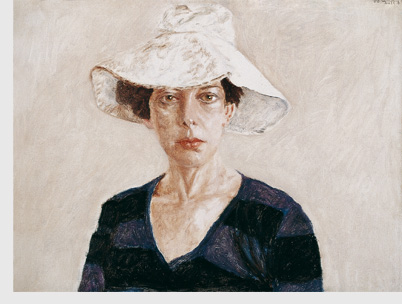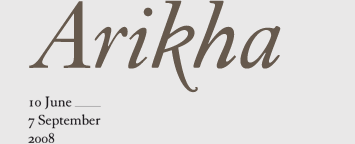
Avigdor Arikha
Anne in summer, Jerusalem, 20rd july 1980
Oil on canvas, 46 x 61 cm
Private collection
Anne in summer, Jerusalem, 20rd july 1980
Oil on canvas, 46 x 61 cm
Private collection



Arikha is a “re-born” artist, one who has died and returned to life several times. The first occasion was when he was little more than a child and was torn from his home, deported with his family and thrown into concentration camps. During that terrible period his father died but Arikha miraculously survived thanks to some of his drawings. Rescued from the shadows, he was taken in May 1944 to the Jewish refuge of Eretz-Israel in Palestine and for five years lived in the Ma’aleh-Hahmisha kibbutz near Jerusalem, working on the farm, studying and receiving military training. His artistic education began slightly after this in the Bezalel School. In his new homeland, this new collective home, one of his teachers also gave him a new name, replacing the old family surname of Dlugacz, which means “broad”, with its Arameic translation of Arikha. The first resurrection is symbolised in this change of name.
The second resurrection took place some time afterwards. Arikha enlisted in the Jewish defence force known as the Haganah and fought in its ranks in the turbulent days at the end of the British mandate in Palestine. On 18 January 1948 when he was part of the armed escort of a convoy, he was seriously wounded by the terrible dum-dum exploding bullets. During his agony he experienced a strange out-of-body sensation. He was given up for dead and his “corpse” was taken to a mortuary where a nurse read his name on a label and notified his sister. Arikha’s sister arrived and convinced a doctor to operate on him. After the operation, Arikha was in a coma for six days then came back from that land of no return.
The third resurrection was not a physical but rather a spiritual one, and is to be seen in the realm of painting. As the artist has explained on numerous occasions, in late February or early March 1965 he visited the Louvre to see the exhibition Le Caravage et la peinture italienne du XVIIème siècle. One painting by Caravaggio particularly struck him: The Resurrection of Lazarus. Arikha suddenly realised that modern art had become Mannerist, just as in Rome in the time of Caravaggio. He felt that his vocation as an abstract painter had come to an end.
A few days later, on 10 March 1965 Avigdor Arikha got up in the morning and experienced an overwhelming desire to draw from life, possessed, as he put it, by a tremendous “hunger of the eyes”. Arikha asked his wife Anne to pose for him and attempted to draw her portrait. The work was not a success and he felt discouraged but returned to try again and again with an unprecedented passion. At the end of the day he had produced around thirty drawings in brush and sumi ink, drawings that he would later destroy as unsatisfactory. However, his fever did not abate. On the following day Arikha returned to drawing, and the next day and the next and so on for weeks and months, primarily in brush and ink. His new start was beginning to take shape. For eight long years Arikha devoted himself to drawing from life, to making prints and to studying art history. Finally, on 20 September 1973, following his return from a period in Israel, he suddenly experienced a violent need to paint from life and felt himself equipped to do so.
Since then Arikha has remained faithful to this procedure of working from life, which he considers the only way to preserve the traces of the lived experience. For Arikha, the more a work of art moves away from any generic abstraction and focuses on the individual nature of the model, the closer it will come to the truth. For this artist, all painting is a sort of portrait: “When I paint a face it has to be this face, not a generalised one, not a generalised apple, but this one in particular.” Just as each moment in life is unrepeatable, so Arikha does not allow himself to retrace his steps in order to revise or modify his work. As in Goethe’s Faust, painting holds on to the moment, pleading with it: “Abide thee yet a while, thou art so fair…”
LUDWIG VAN BEETHOVEN (1771-1827)
Trio for piano, violin and violonchello in doh minor, op. I No. 3
Concert in honor of Avigdor Arikha. TRÍO ARTARIA (Joan Espina, violin; Beate Altenburg, violonchello; Jesús Gómez Madrigal, piano)

The second resurrection took place some time afterwards. Arikha enlisted in the Jewish defence force known as the Haganah and fought in its ranks in the turbulent days at the end of the British mandate in Palestine. On 18 January 1948 when he was part of the armed escort of a convoy, he was seriously wounded by the terrible dum-dum exploding bullets. During his agony he experienced a strange out-of-body sensation. He was given up for dead and his “corpse” was taken to a mortuary where a nurse read his name on a label and notified his sister. Arikha’s sister arrived and convinced a doctor to operate on him. After the operation, Arikha was in a coma for six days then came back from that land of no return.
The third resurrection was not a physical but rather a spiritual one, and is to be seen in the realm of painting. As the artist has explained on numerous occasions, in late February or early March 1965 he visited the Louvre to see the exhibition Le Caravage et la peinture italienne du XVIIème siècle. One painting by Caravaggio particularly struck him: The Resurrection of Lazarus. Arikha suddenly realised that modern art had become Mannerist, just as in Rome in the time of Caravaggio. He felt that his vocation as an abstract painter had come to an end.
A few days later, on 10 March 1965 Avigdor Arikha got up in the morning and experienced an overwhelming desire to draw from life, possessed, as he put it, by a tremendous “hunger of the eyes”. Arikha asked his wife Anne to pose for him and attempted to draw her portrait. The work was not a success and he felt discouraged but returned to try again and again with an unprecedented passion. At the end of the day he had produced around thirty drawings in brush and sumi ink, drawings that he would later destroy as unsatisfactory. However, his fever did not abate. On the following day Arikha returned to drawing, and the next day and the next and so on for weeks and months, primarily in brush and ink. His new start was beginning to take shape. For eight long years Arikha devoted himself to drawing from life, to making prints and to studying art history. Finally, on 20 September 1973, following his return from a period in Israel, he suddenly experienced a violent need to paint from life and felt himself equipped to do so.
Since then Arikha has remained faithful to this procedure of working from life, which he considers the only way to preserve the traces of the lived experience. For Arikha, the more a work of art moves away from any generic abstraction and focuses on the individual nature of the model, the closer it will come to the truth. For this artist, all painting is a sort of portrait: “When I paint a face it has to be this face, not a generalised one, not a generalised apple, but this one in particular.” Just as each moment in life is unrepeatable, so Arikha does not allow himself to retrace his steps in order to revise or modify his work. As in Goethe’s Faust, painting holds on to the moment, pleading with it: “Abide thee yet a while, thou art so fair…”
LUDWIG VAN BEETHOVEN (1771-1827)
Trio for piano, violin and violonchello in doh minor, op. I No. 3
Concert in honor of Avigdor Arikha. TRÍO ARTARIA (Joan Espina, violin; Beate Altenburg, violonchello; Jesús Gómez Madrigal, piano)
